

Stem Cells: The Solution to Living Over 100 Years? Although medical treatments have increased the average human life expectancy, these treatments have yet to increase lifespan over a hundred years.
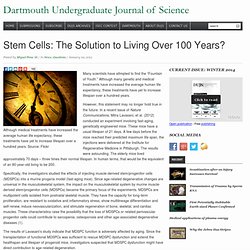
Source: Flickr Many scientists have attmpted to find the “Fountain of Youth.” Although many genetic and medical treatments have increased the average human life expectancy, these treatments have yet to increase lifespan over a hundred years. However, this statement may no longer hold true in the future. In a recent issue of Nature Communications, Mitra Lavasani, et al. (2012) conducted an experiment involving fast-aging, genetically engineered mice. Harmonizing a Broken Heart: Stem Cells Keep Cardiac Beat in Synchrony. First Posted: Sep 04, 2013 03:00 PM EDT Stem cell therapy used to regenerate injured tissue in the heart also restores synchronous pumping, new research shows, and could thus be used to make pacing devices redundant.
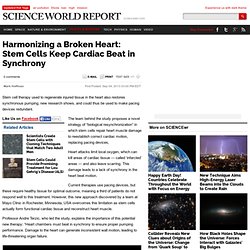
Like Us on Facebook The team behind the study proposes a novel strategy of “biological resynchronization” in which stem cells repair heart muscle damage to reestablish correct cardiac motion, replacing pacing devices, Heart attacks limit local oxygen, which can kill areas of cardiac tissue — called ‘infarcted’ areas — and also leave scarring. This damage leads to a lack of synchrony in the heart beat motion. Current therapies use pacing devices, but these require healthy tissue for optimal outcome, meaning a third of patients do not respond well to this treatment. Professor Andre Terzic, who led the study, explains the importance of this potential new therapy: “Heart chambers must beat in synchrony to ensure proper pumping performance.
Scientists Grow Human Brain From Stem Cells. Ear, eye, liver, windpipe, bladder, and even a heart.

The list of body parts grown from stem cells is getting longer and longer. Tooth-Derived Stem Cells Make Brain-Like Cells. Treatment of strokes may be revolutionized as researchers from the University of Adelaide managed to create brain-like cells out of stem cells extracted from dental pulp.
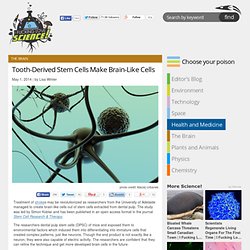
The study was led by Simon Koblar and has been published in an open access format in the journal Stem Cell Research & Therapy. The researchers dental pulp stem cells (DPSC) of mice and exposed them to environmental factors which induced them into differentiating into immature cells that created complex patterns, just like neurons. Though the end product is not exactly like a neuron, they were also capable of electric activity. The researchers are confident that they can refine the technique and get more developed brain cells in the future. Each year in the United States, about 795,000 people will have have a cerebrovascular accident (also known as a stroke) and the episode will be fatal for about 140,000 of them. Treatment depends on the cause of the stroke, but there really isn’t much that can be done. New Stem Cells on the Block. Microscope Imaging Station. Stem Cells: Cells with Potential.
What are stem cells?
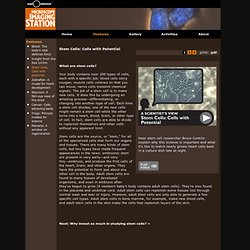
Your body contains over 200 types of cells, each with a specific job: blood cells carry oxygen; muscle cells contract so that you can move; nerve cells transmit chemical signals. The job of a stem cell is to make new cells. It does this by undergoing an amazing process—differentiating, or changing into another type of cell. Engineering 3D-printed stem cells. Inside the stem cell printer.
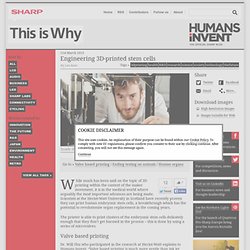
While much has been said on the topic of 3D printing within the context of the maker movement, it is in the medical world where arguably the most important advances are being made. Scientists at the Heriot-Watt University in Scotland have recently proven they can print human embryonic stem cells, a breakthrough which has the potential to revolutionise organ replacement in the coming years.
The printer is able to print clusters of the embryonic stem cells delicately enough that they don’t get harmed in the process – this is done by using a series of microvalves. Valve based printing Dr. New Stem Cells on the Block. Getting stem cells from urine. Human induced pluripotent stem cells (iPSCs) have been generated with varied efficiencies from multiple tissues.
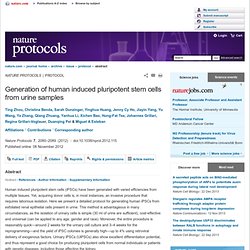
Yet, acquiring donor cells is, in most instances, an invasive procedure that requires laborious isolation. Here we present a detailed protocol for generating human iPSCs from exfoliated renal epithelial cells present in urine. This method is advantageous in many circumstances, as the isolation of urinary cells is simple (30 ml of urine are sufficient), cost-effective and universal (can be applied to any age, gender and race).
Moreover, the entire procedure is reasonably quick—around 2 weeks for the urinary cell culture and 3–4 weeks for the reprogramming—and the yield of iPSC colonies is generally high—up to 4% using retroviral delivery of exogenous factors. View full text Figures. Cells of the immune system. Roadmap Epigenomics Project - Data. Scientists create animals that are part-human - Health - Cloning and stem cells. Stem-Cell-Coated Contact Lenses Are Curing the Blind. Researchers in Australia have come up with an outwardly simple but incredibly ingenious way of curing blindness caused by corneal damage: Take everyday contact lenses, already used by millions (including me), and infuse them with a patient's own stem cells.

After wearing them for about 2 weeks, test subjects reported a seemingly miraculous restoration of sight. Is it that easy? Most of the patients had only lost vision in one eye, so stem cells were harvested from their good eye and then plated onto contact lenses. After letting the stem cells repair damaged tissues, 2 of the 3 patients went from legally blind to being able to read some of an eye chart. The third patient actually regained enough sight to pass a driving exam.
So far they've only targeted corneal damage, which is estimated to be the cause of sight loss in about 1.5 million people every year. Still, amazing stuff. Above is a video explaining the technique. [UNSW via Gizmodo] All-StemCell-Research. Stem Cell Research. Stem cells. Human neural stem cells study offers new hope for children with fatal brain diseases.
Public release date: 10-Oct-2012 [ Print | E-mail Share ] [ Close Window ] Contact: Tamara Hargens-Bradleyhargenst@ohsu.edu 503-494-8231Oregon Health & Science University PORTLAND, Ore. – Physician-scientists at Oregon Health & Science University Doernbecher Children's Hospital have demonstrated for the first time that banked human neural stem cells — HuCNS-SCs, a proprietary product of StemCells Inc. — can survive and make functional myelin in mice with severe symptoms of myelin loss.
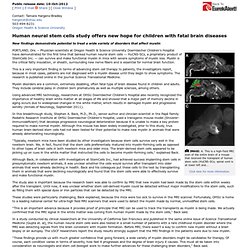
Myelin is the critical fatty insulation, or sheath, surrounding new nerve fibers and is essential for normal brain function. This is a very important finding in terms of advancing stem cell therapy to patients, the investigators report, because in most cases, patients are not diagnosed with a myelin disease until they begin to show symptoms. Myelin disorders are a common, extremely disabling, often fatal type of brain disease found in children and adults. In this breakthrough study, Stephen A. Particulars. Stem cells & development. Scientists Turn Back the Clock on Adult Stem Cells Aging. Posted September 20, 2011 | Atlanta, GA Researchers have shown they can reverse the aging process for human adult stem cells, which are responsible for helping old or damaged tissues regenerate.
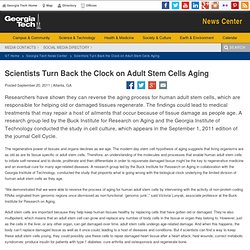
The findings could lead to medical treatments that may repair a host of ailments that occur because of tissue damage as people age. A research group led by the Buck Institute for Research on Aging and the Georgia Institute of Technology conducted the study in cell culture, which appears in the September 1, 2011 edition of the journal Cell Cycle. Project Stem Cell to Neuron: a MIT/Whitehead/Columbia Collaboration - Home. A Squirt of Stem Cell Gel Heals Brain Injuries.
Scientists have developed a gel that helps brains recover from traumatic injuries. It has the potential to treat head injuries suffered in combat, car accidents, falls, or gunshot wounds. Developed by Dr. Stem cells bring back feeling for paralysed patients - health - 03 September 2012. For the first time, people with broken spines have recovered feeling in previously paralysed areas after receiving injections of neural stem cells. Three people with paralysis received injections of 20 million neural stem cells directly into the injured region of their spinal cord. The cells, acquired from donated fetal brain tissue, were injected between four and eight months after the injuries happened. The patients also received a temporary course of immunosuppressive drugs to limit rejection of the cells. None of the three felt any sensation below their nipples before the treatment. Six months after therapy, two of them had sensations of touch and heat between their chest and belly button. “The fact we’ve seen responses to light touch, heat and electrical impulses so far down in two of the patients is very unexpected,” says Stephen Huhn of StemCells, the company in Newark, California, developing and testing the treatment.
Advertisement Persistent gains Abandoned trial.
Stem Cell Fraud.